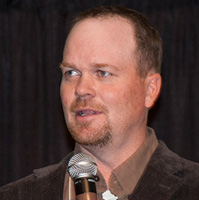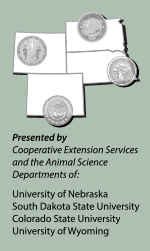Nutritional Management
Following AI
by Troy Smith, field editor, Angus Journal
RAPID CITY, S.D. (Dec. 3, 2013) — A failure to achieve anticipated pregnancy rates among heifers bred by artificial insemination (AI) might not be due to low fertility. It might not be due to improper AI technique. Even when heifers are well-developed and fertile, and when synchronization protocols and insemination are performed correctly, results are sometimes disappointing.

“We sometimes forget that high-concentrate diets can put heifers at a disadvantage when they go back to an all-forage diet,” said Scott Lake, UW beef cattle specialist.
Speaking at the Range Beef Cow Symposium (RBCS) Dec. 3-5 in Rapid City, S.D., Scott Lake reminded cow-calf producers that pregnancy rates can suffer when post-AI heifer diets change abruptly. The University of Wyoming beef cattle specialist said shifting heifers to a lower plane of nutrition after AI is particularly risky.
Lake said replacement heifers are commonly developed in drylots and fed relatively high-energy diets. Such heifers often cycle well and respond to estrous synchronization protocols.
“We sometimes forget that high-concentrate diets can put heifers at a disadvantage when they go back to an all-forage diet. Heifers bred in the spring may be turned out on grass that is washy, too. They can’t get the calories they are used to,” said Lake. “A drop to a maintenance diet can put them on a negative plane of nutrition immediately after AI, and it can result in lower pregnancy rates.”
Lake cited evidence indicating that heifers transitioned from drylot to pasture can lose more than three pounds per day during the first week. Research suggests heifers whose dietary plane of nutrition decreases immediately following AI may exhibit decreased AI pregnancy rates and decreased overall breeding season pregnancy rates. Post-AI nutrient restriction may also result in poor quality embryos that are unable to successfully signal maternal recognition of pregnancy. The result is early embryo loss.
According to Lake, these results suggest that the early embryo, oviduct and uterus are sensitive to immediate changes in nutrition. In addition, nutrient restriction following breeding appears to alter oviductal and uterine support for embryo growth and pregnancy recognition. Lake advised producers to manage nutrition so that breeding females do not experience a negative energy balance following AI.
Lake spoke Tuesday at RBCS XXIII. Visit the Newsroom at www.rangebeefcow.com/2013 view his PowerPoint, read his proceedings paper or listen to his presentation.
---------------------
The RBCS is a biennial educational symposium offering practical production management information. It is sponsored by the Cooperative Extension Service and animal science departments of the University of Wyoming, South Dakota State University, Colorado State University and the University of Nebraska.
Comprehensive coverage of the symposium is available online at www.rangebeefcow.com. Compiled by the Angus Journal editorial team, the site is made possible through sponsorship of LiveAuctions.tv and the cooperation of the host committee.
Editor’s Note: This article was written under contract or by staff of the Angus Journal. To request reprint permission and guidelines, contact Shauna Rose Hermel, editor, at 816-383-5270.


